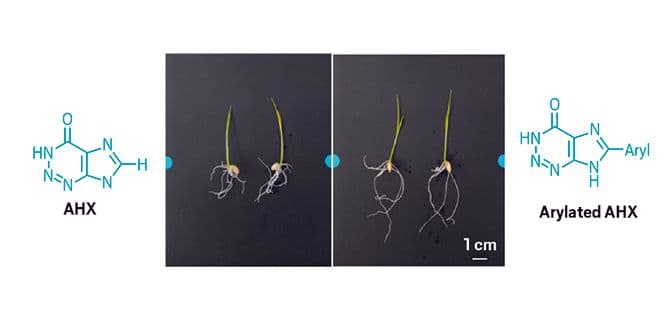Underlying lush circles of turf called “fairy rings” is a natural product made by fungi that spurs the growth of grass. Researchers have now created a bioactive compound that stimulates this growth even better than the natural compound. Crafted via C–H activation, these potent variants should help elucidate the fairy ring chemical mechanism and may […]

Underlying lush circles of turf called “fairy rings” is a natural product made by fungi that spurs the growth of grass. Researchers have now created a bioactive compound that stimulates this growth even better than the natural compound. Crafted via C–H activation, these potent variants should help elucidate the fairy ring chemical mechanism and may eventually be used in agriculture to increase crop yields.
More than 10 years ago, Hirokazu Kawagishi noticed circles of darker, taller grass on his campus grounds at Shizuoka University and wondered what caused them. After mushrooms popped up in the patches of grass, he realized the circles were the fairy rings of folklore, which scientists now know are caused by fungi that stimulate or squash growth in nearby plants. Intrigued, Kawagishi isolated from the mushrooms (Lepista sordida) the molecule responsible for the growth: 2-azahypoxanthine (AHX). He dubbed it and its close metabolites fairy chemicals.
Kawagashi and his colleagues then found that every crop they tested (including rice, wheat, corn, tomatoes, and tobacco) not only responded to AHX but also made AHX on its own. This led him to hypothesize that fairy chemicals belong to a previously unknown family of growth hormones active in plants and possibly in fungi and algae as well.
To help study how AHX acts in plants, Kawagishi attempted to derivatize the compound. He found it difficult. AHX has only three possible hydrogen substitutions, and alkylating the N-H bonds, it turned out, took away its activity. The remaining carbon-hydrogen bond on the imidazole ring was the only option for creating more active derivatives. That’s a tricky spot. That particular carbon has a lower reactivity than its neighboring nitrogens, and AHX itself is rather unstable.
For the current study, Kawagishi recruited Kenichiro Itami of Nagoya University to help. Itami works in C–H functionalization: activating a traditionally inert C–H bond so the hydrogen swaps out more easily. Using a palladium and copper catalytic system to activate the C–H bond (with protecting groups on the nitrogens), the researchers created eight arylated AHX analogs.
They soaked germinated rice seeds in solutions of the new compounds for a week, then measured the roots and shoots. To the researchers’ delight, all of the arylated variations spurred stronger growth—some, much stronger—than natural AHX. Rice roots grown in phenylated AHX, for example, grew about 1.5 times as deep as rice roots grown in AHX alone and twice as deep as rice grown in water.
Kawagishi sees immense potential for these compounds in industrial agriculture. Previously, he worked with an agricultural company to test AHX on rice, wheat, spinach, and tomato as a possible crop growth promoter. Field experiments with AHX alone on rice and wheat showed 10–20% increases in grain yields. The AHX derivatives, he believes, could increase yields more. Kawagishi is now investigating the derivatives to determine whether they work via the same mechanism as AHX. (In rice, Kawagishi has found, AHX spurs growth by boosting ammonium absorption in the roots and increasing the activity of enzymes that protect the plant from stresses like salt and chilly temperatures.)
The pharmaceutical industry has shown a huge amount of interest in C–H functionalization and the new reactions made possible by activating C–H bonds, says Huw Davies of Emory University. “This is an intriguing paper illustrating how you can use the logic of C–H functionalization to impact the agrochemical area as well.”
It can take a long time, Kawagishi says, for the agricultural industry to vet a molecule as a viable and safe plant growth regulator. But he hopes that within a decade a fairy chemical could help feed the world.
